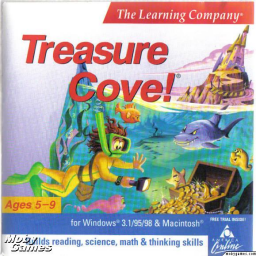Does anybody know how Oddtom (if he could respond here himself that would be even better) was able to guess where the pufferfish was with 100% accuracy in his run?
I've been running on the Windows version because screen transitions are faster than on DOS, but this indicates there may be some sort of luck manipulation strat on DOS. If so, and we find out the same sort of luck manipulation cannot be done on Windows, then we may need to think about making DOS and Windows different categories.
Hello! So I'm not the only person interested in this game, heh.
Hey, I just saw your message on Twitch, so I'll respond to both of them here if that's okay. TL;DR I used statistics. I submitted the one where I happened to be right three times in a row, but what you don't see is all the ones where I didn't get it right.
In more detail: I live about an hour light rail ride south of Seattle, and every time I rode in to work, I'd make a single run and record what the clues were. I was curious to see if there was a repeating list of clues or if certain clues were used more often than others. In cryptography, there are different types of "random", and some are easier to predict than others. For instance, a truly random number selected from the set [1,2,3,4,5] should result in more or less the same number of occurrences of each, but a truly random number selected from the set [1,1,1,1,1,2,3,4,5] will result in "1" more often than the others, even if the selector is truly random. This seems to be the case (in at least my version) for certain variables (for instance, the number "2" in clues for the first stage seems to be more frequent than other numbers, and certain clues seem to be tied together, for instance, if you see four flounders, you can pass right by it, because I've only ever seen the clue "three brown flounders". I'm sure there's more I'm not catching, but it's basically just using probability based on known data sets.
On a slightly different note, I've never actually seen your version before; I was wondering why you were using an updated program when the original is much easier to find. I've been using the emulator on this site:
https://classicreload.com/treasure-cove.html
I like it because once the game loads, it doesn't require an active internet connection.
I just found this, it's a pretty good thesis on the subject of randomness and random number generation:
http://digitalcommons.liberty.edu/cgi/viewcontent.cgi?article=1311&context=honors
Ok so you're not using a tool like the one you use in this forum post? http://www.speedrun.com/Super_Solvers_Gizmos_and_Gadgets/thread/kluj5 Such a tool should be fair game, imo, but from what I understand, you're simply using very detailed notes after many observations to predict what combination of sea creatures will most likely house the pufferfish on each stage.
Very interesting, I've always just assumed the clues in this game were truly random. In that case, I'll try doing some statistical analysis of the Windows version tonight, and then we can compare results later on. Hopefully I will find some interesting patterns, as I'd like to continue running on this version of the game :P
Haha, no tools here, just careful observation and educated guessing. This game isn't quite complicated enough to warrant something like that. The maps are super simple, and I'm pretty sure the location of the puffer fish really is randomized (not a good way I can think of to predict it anyway... yet...), and though I also feel like the three sets of clues are randomized, I think they are picked from a pool of three clues bound together rather than picked randomly individually, and I think that's the key to speedrunning any% one level.
Even if the variables are randomized, there are different classes of "random", and it takes a lot of work to make something truly random (i.e. every possibility has an equal chance of appearing), and I doubt that this game's developers really went into that much effort for what is essentially just a children's educational game. All the software devs I know have this attitude of "if it works, leave it alone- functionality first, optimization later if needed". You can probably tell from my work here and with Gizmos, but my particular field tries to find better or unique ways of approaching problems that may seem unsolvable using conventional approaches. I love math and I speak "computer", so figuring out the inner workings of a simple program like this and using it to find patterns or exploits is just one of my hobbies.
I think that's one of the things I like most about the speedrunning community- there are just as many ways to solve a problem as there are types of people making speedrunning videos, and there is no one "accepted" way to speedrun a game; all approaches are respected equally (at least within the community)
Hey, and I'd be interested as well to see how the variables hold out from one version to the next. How much did the developers change when porting the game from DOS to Windows? Do you also get the same clues over and over when replaying the first level over and over? Is there a discernible pattern to the puffer fish location or the clues or anything else that might stand out? (where the stars first appear on the screen, what the first objects that spawn below you are, etc.) I don't know how much you know about software development or how these variables are defined, stored, or manipulated, but I think it would be interesting to have someone else to discuss these with.





